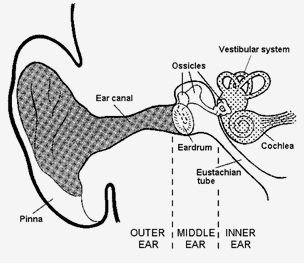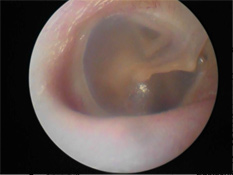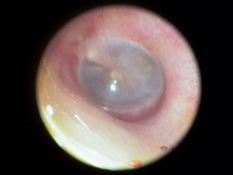- Parent Info
- FUNCTION OF THE EAR
Anatomy and Function of the Ear
 Study of the structure and function of various parts of the ear is needed to understand the different types of hearing loss and the methods used in preventing or treating hearing loss. The ear can be divided into three parts, which work together, they are the outer ear, the middle ear and the inner ear.
Study of the structure and function of various parts of the ear is needed to understand the different types of hearing loss and the methods used in preventing or treating hearing loss. The ear can be divided into three parts, which work together, they are the outer ear, the middle ear and the inner ear.
Basic Anatomy of the Ear
The Outer Ear
The outer ear consists of the pinna and the ear canal ending in but not including the eardrum. The outer ear works like a funnel. It directs sound down the ear and helps localize sound. The ear canal is about 24mm (1 inch) long. It has two bends and ends at the ear drum. The outer two thirds of the canal is formed of cartilage and the rest is bone.
The ear canal is lined with skin. The skin of the outer two thirds is the same as on the rest of the body. The skin contains sweat glands and special glands, which produce wax (cerumen). The wax is sticky and antibacterial and helps waterproof the canal. This prevents small particles from entering the canal and keeps a healthy ear free from infection. The skin is covered with hairs that help move dirt out of the canal. The ear canal ends at the ear drum.
The eardrum has three layers. The outer layer is skin; the middle layer is fibre which gives the ear drum its bounce; and the inner layer of mucous membrane which is part of the lining of the middle ear.
Otoscopic features of the eardrum showing the ossicular chain :


The Middle Ear
The middle ear is an air filled cavity, bridged by the ossicular chain. It passes sound from the eardrum to the inner ear. The ossicular chain is made up of three small bones, the hammer, (malleus) anvil (incus) and stirrup (stapes) .The hammer is attached to the eardrum. The stapes footplate rests on the membrane-covered oval window of the inner ear. When sound waves move the eardrum, they are transferred mechanically through the ossicular chain to the inner ear.
The middle ear is connected to the back of the nose by the Eustachian tube. This connection allows for pressure to be equalized during swallowing, yawning and sneezing. It also acts as a drain. The Eustachian tube is shorter in children and is more likely to get contaminated from the back from the nose. It is because of the difference in the shape and function that makes young children prone to ear disease.
The Inner Ear
The inner ear is a very delicate mechanism. For protection it is located deep in the skull behind the eyes. The inner ear is filled with fluid and contains two sensory systems, the balance and the hearing systems. The back section of the inner ear consists of three canals which give us our balance and help in the stabilisation of eye movement. These are the semi circular canals and are known as the vestibular system.
The hearing system is contained in the cochlea and the auditory nerve. The purpose of the cochlea is to change the signal from a sound message to an electrical message. These electrical messages are sent to the brain by the auditory nerve. The cochlea is a fluid filled snail shell like structure. In it there are about 30,000 tiny nerve endings called hair cells and all these connect to the fibres of the auditory nerve which transmits the sound message to the brain.
Call us today on (08) 9389 1622 or head to our Contact Us page and send us a message via the website.